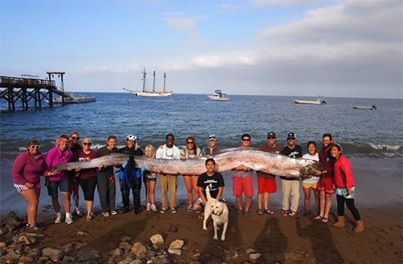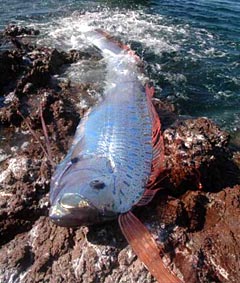The elusive oarfish

On October 16, 2013, CNN mentioned the discovery of an 18-foot-long, silvery fish. This fish, found fifteen feet below the surface off the southern California coast, had reddish fins and eyes the size of a half-dollar. Jasmine Santana, the marine science instructor, recognized the fish and dragged the dead carcass to shore.
But few outside of marine biologists would know what this huge animal was, since oarfish dive over 3,000 feet deep in their native temperate and tropical waters and are usually only seen on the surface when they are dead and not eaten up by undersea scavengers.
The most common scientific name for this fish is Regalecus glesne, dubbed in 1772 by Ascanius, but there are at least fourteen other scientific named assigned to the same fish between 1788 and 1914, giving it the genus Regalecidae, Cepola, Gymnetrus, or Cephalepis. Because of its rarity, these are probably all the same fish; with modern communications such a confusion no longer exists. The name comes from the Latin regalis, meaning royal. According to the Guiness Book of World Records, this is the longest bony fish alive. The common name, oarfish, probably comes from the old belief that it propels itself through the water by “rowing” with the pelvic fins. Other common names include ribbon fish, king of herrings, slender oarfish, “Messenger from the Sea God’s Palace” and sea serpent. In Japan, there is a tale that when “ryugu no tsukai” comes to the shore, an earthquake is imminent. There might be some credence to this myth, since oarfish swim so deep, near fault limes, and may be able to sense the vibrations.

Its habitat is from 600 feet (200 meters) to 3,280 feet (1,000 meters) deep, in the Atlantic Ocean, the Mediterranean, and the Pacific Ocean from Topango Beach, southern California to Chile. However, this is only anecdotal, by sightings; scientists believe it could range any ocean or large sea except in polar regions. They have been known to come to the surface at night, apparently attracted to lights on boats.
What is known or assumed about the oarfish comes from specimens which have washed ashore or from those caught by fishermen. It is not fished commercially because its gelatinous flesh is considered inedible, but there have been occasions when oarfish were fished for sport.

Reaching a length of over 50 feet (15 meters), weighing as much as 600 pounds (272 kg), Regalecus glesne has no scales, a silver to silvery blue skin, and a dorsal fin the entire body length that is red and forms a type of crest at the head. This dorsal fin is rather ornate, with a tiny spine projecting above each of over 400 fin rays. The oar-like pelvic fins are also red. Since the oarfish has a small mouth with no visible teeth, its diet consists of plankton, small crustaceans and small squid strained from the water by gill rakes in the mouth. . It is believed that sharks and other large fish might be the predators of the oarfish.
Besides “rowing” with the pelvic fins, oarfish have been observed swimming in a vertical position (perhaps searching for food) as well as undulating the long dorsal fin while keeping the body straight.
Oarfish are believed to be solitary as adults. They have been observed spawning off the Mexican coast between July and December, abandoning the eggs which contain droplets of oil to float on the ocean surface until they hatch, which takes up to three weeks. The hatched larvae feed on plankton until they mature. It isn’t known if there are other spawning areas nor what type of migration these fish may follow.
When you think about how elusive the oarfish is, how rare a sighting is, how cosmopolitan its range of habitat, and how large it usually is in length, it is not surprising that this may well be the source of so many sightings of “sea serpents” around the globe.

© 2014 Bonnie-Jean Rohner



